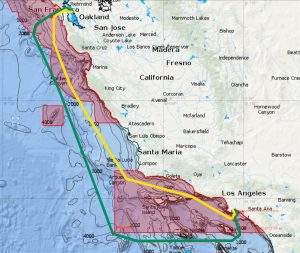
Oakland Schedule Adjustment to Increase Whale Safety
Oakland Schedule Adjustment to Increase Whale Safety
Shipping channels into and out of San Francisco Bay and the Los Angeles/Long Beach port complex transit federally protected national marine sanctuaries. These sanctuaries –Monterey Bay, Greater Farallones, and Cordell Bank national marine sanctuaries–are destination feeding areas for threatened and endangered humpback and blue whales from late spring through the fall.
In 2015, these sanctuaries coordinated with Channel Islands National Marine Sanctuary to issue voluntary vessel speed reduction requests for the period of peak whale abundance off the San
Francisco and southern California coasts between May 1 through December 15 to reduce the risk of collisions between vessels and whales.

In 2022, these National Oceanic and Atmospheric Administration (NOAA) marine sanctuaries, in collaboration with the United States Coast Guard (USCG) and the U.S. Environmental Protection
Agency (EPA), implemented a Vessel Speed Reduction (VSR) program requesting vessels 300 GT (gross tons) and larger to reduce speed to 10 knots (11.5 mph) maximum speed in the shipping lanes approaching and leaving San Francisco Bay, as a way to further reduce fatal collisions between ships and whales.
In 2023, the San Francisco region VSR zone was expanded to include the Monterey Bay National Marine Sanctuary, and the southern California VSR zone was expanded to include recent International Maritime Organization (IMO) modifications to the Santa Barbara Channel Traffic Separation Scheme (TSS) and Area To Be Avoided (ATBA).
In order to do its part to help reduce the risk of collision with whales off the California coast year-round, Matson is making route adjustments to its weekly triangulating Oakland-Long Beach-Honolulu voyage to minimize the amount of time its vessels spend inside these expanded protection zones. Doing so will lengthen the route and result in a longer transit time between Oakland and
Long Beach, so the Oakland departure schedule for this voyage will be advanced by eight hours to allow more time for these coastal transits.
Understanding that this change will require significant adjustments for some customers as well, Matson has given them two months’ notice. Our midweek sailing from Oakland will now depart
Wednesdays at 1800, effective with the Wednesday, August 2, 2023 sailing.
“It won’t be an easy transition, but the bottom line is that we believe this is the right thing to do, and that’s who Matson is as a company. We’re committed to doing our part to protect
vulnerable whale populations,” said John Lauer, executive vice president and chief commercial officer.
